Chau Say Tevoda Temple A Guide To Explore Cambodia’s 12th Century Wonder In 2025
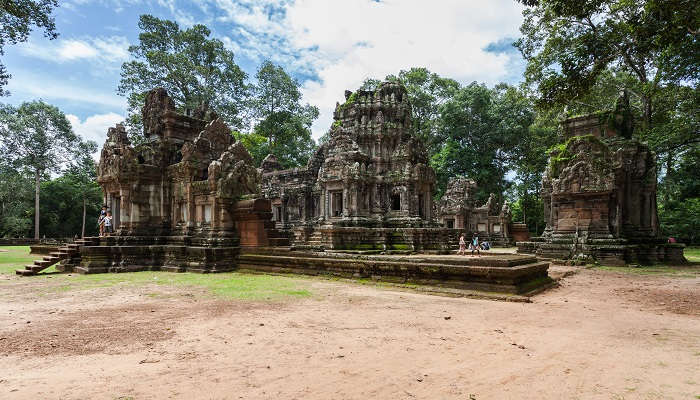
Nestled in the heart of Cambodia’s Siem Reap province, Chau Say Tevoda is a captivating village that offers a glimpse into the country’s rich cultural heritage. This destination, situated along the banks of the Siem Reap River, invites visitors to immerse themselves in the authentic Khmer way of life. From the vibrant local markets brimming with fresh produce and handcrafted wares to the ornate temples that stand as a testament to Cambodia’s glorious past, Chau Say Tevoda promises an unforgettable experience.
About Chau Say Tevoda
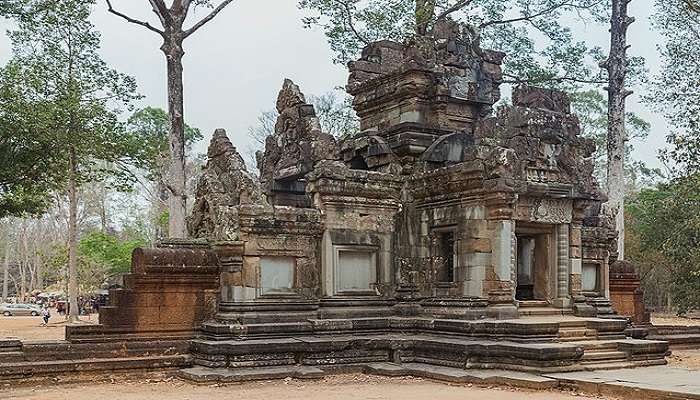
Chau Say Tevoda is a Hindu temple from the Angkor Wat period, located just east of Angkor Thom and directly south of Thommanon, across the Victory Way in Cambodia. Constructed in the mid-12th century, the temple is dedicated to Shiva and Vishnu and features unique female sculptures called devatas. It also contains Buddha images believed to have been added during the reign of Dharanindravarman, father of Jayavarman VII, who ruled from Preah Khan of Kompong.
The temple had fallen into a dilapidated state, with 4,000 elements scattered along the embankment and in the Siem Reap River. From 2000 to 2009, a Chinese team undertook restoration work using many scattered elements under a project sponsored by the People’s Republic of China. Chau Say Tevoda was reopened to the public in late 2009.
Also Read: Tonle Sap Lake Cambodia
History Of Chau Say Tevoda
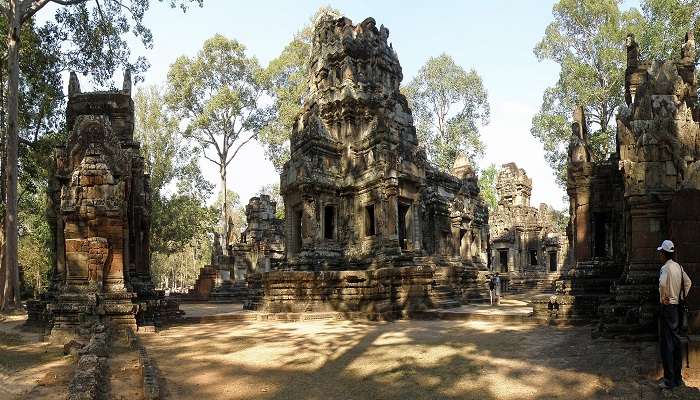
Initially constructed in the mid-12th century during the reign of King Suryavarman II, Chau Say Tevoda underwent further enhancements under the rule of Jayavarman VII. Initially built by Hindu kings, the temple primarily honoured Hindu deities like Shiva and Vishnu.
However, representations of Buddha images were added later, believed to have been during the reign of Dharanindravarman, the father of Jayavarman VII, who ruled from Preah Khan Kompong Svay. A Chinese team facilitated the temple’s restoration between 2000 and 2009. The reconstruction effort, sponsored by the People’s Republic of China, utilised approximately 4,000 scattered elements found on-site.
Architecture Of Chau Say Tevoda
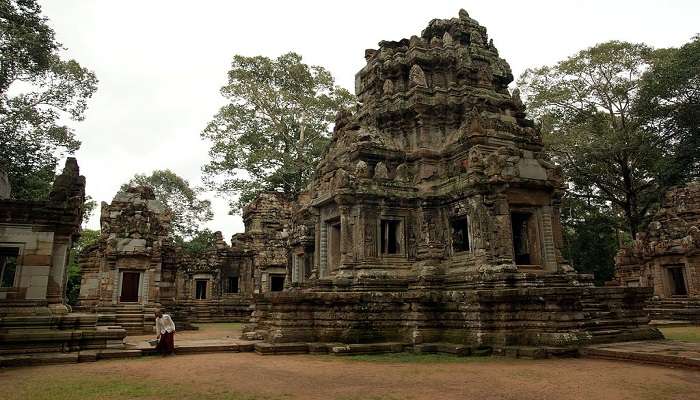
The Tevoda temple, constructed in a cruciform layout reminiscent of Hindu temples in India, particularly those in Odisha, features four gopuras or towers at its cardinal points. An entrance from the east, accessed via a raised bridge, leads into the temple. Connecting these towers is a lengthy hall adorned with floral motifs. The central structure consists of a towering skyscraper accompanied by a mandapa, linked by a small antarala chamber, with libraries flanking its sides. Enclosed within a boundary wall with four towers, the temple faces eastward, with a raised causeway leading to the Siem Reap River. Despite the prevalence of Vishnu sculptures, the temple venerates Shiva as its primary deity. However, many Buddha sculptures, though present, have been defaced over time. The collapse of portions of the ceiling has exacerbated the temple’s deterioration.
Among the notable features is the unfinished eastern Gopura I, which has a cross-legged Buddha figure surrounded by damaged carvings that may represent Garuda and the king of Nagas. The northern door of this gopura is adorned with carvings showing scenes from Buddha’s life. Additionally, a significant bas-relief depicts Sita from the Ramayana seated on an altar among rakshasis, with a small Hanuman presenting Rama’s ring. Originally in disrepair, with numerous elements scattered along the embankment and in the Siem Reap River, the temple underwent restoration between 2000 and 2009, thanks to a project initiated by the People’s Republic of China. Following this restoration effort, the temple reopened to visitors in late 2009 and is now fully accessible.
Related Post: Choeung Ek Genocidal Center
Things To Do At Chau Say Tevoda
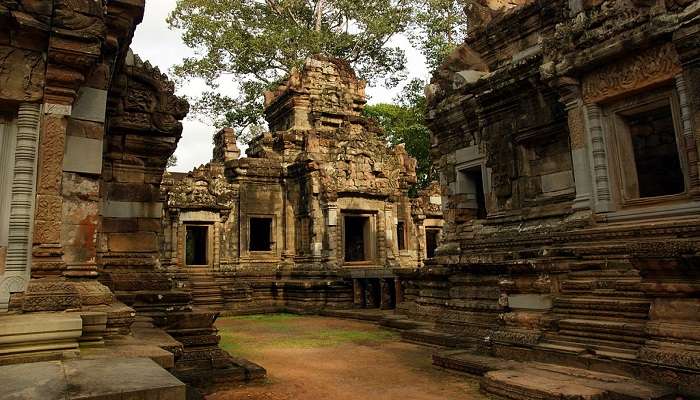
Chau Say Tevoda offers a variety of activities for visitors. Some of them are as follows:
1. Temple Exploration: Constructed in the 12th century by King Suryavarman II, Chau Say Tevoda is a small temple that exemplifies the classic “Angkor Wat” architectural style. The temple is dedicated to the Hindu gods Shiva and Vishnu
2. Photography: After a 9-year restoration project, the temple has become an excellent spot for photography. You can capture beautiful images of this temple.
3. Artwork Observation: The laterite walls of the temple feature four Gopuram gateways in the cardinal directions. Notably, two scenes from the Ramayana, including the death of Valin, are well-preserved on the south side of the east Gopuram.
4. Guided Tours: Numerous tours include visiting the temple, often along with other famous nearby temples such as Ta Prohm.
Timings, Fees, And Best Time To Visit
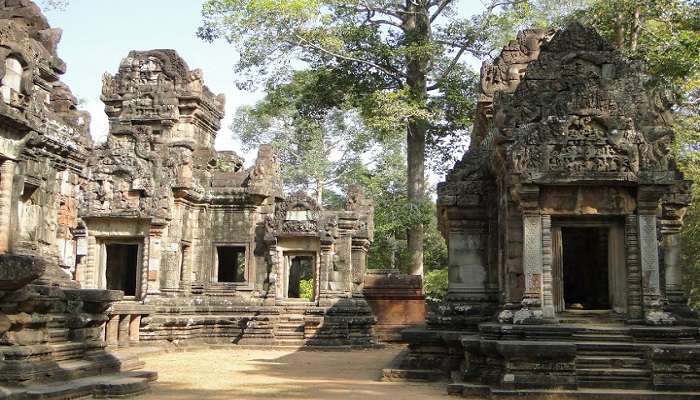
The Chau Say Tevoda temple welcomes visitors from 7:30 AM to 5:30 PM. Entrance to Chau Say Tevoda is included in the Angkor Wat temple pass, which grants access to all the temples within the Angkor Archaeological Park. There are different pass options available, depending on how many days you want to visit the park:
One-day pass: $37
Three-day pass (valid for seven days): $62
Seven-day pass (valid for one month): $72
Tickets can be purchased at the entrance gate of Angkor Wat or online in advance.
The best time to visit Chau Say Tevoda is during the dry season, which runs from November to April. During this time, the weather is sunny and dry, with little rain. However, this is also the peak tourist season, so expect larger crowds. You can visit Chau Say Tevoda during the shoulder seasons (May, June, September, and October) to avoid the crowds. The weather is still relatively good during these times, with only occasional rain showers. The worst time to visit the temple is during the rainy season (July to August). The weather is hot and humid, and there is a high chance of rain. The temples can also become quite slippery during this time.
Related Post: Cambodia Landmine Museum
How To Reach
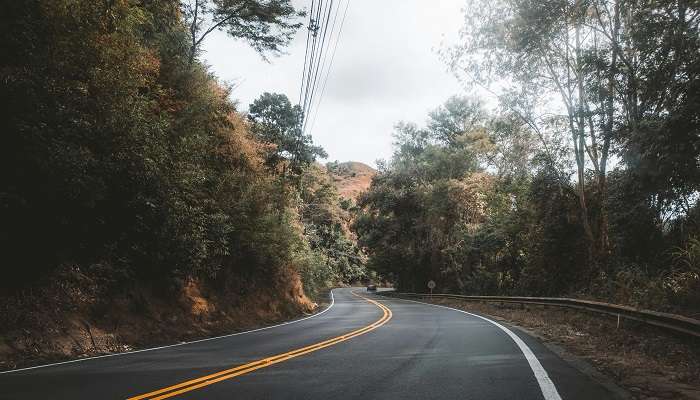
To reach Chau Say Tevoda from Angkor Thom, exit the Victory Gate and proceed along Victory Way. Alternatively, you can start at Angkor Wat and head east toward Srah Srang. From there, turn left, then turn right after Ta Prohm temple. Follow the road to the left, cross the Siem Reap River, and find the temple on the left side.
Chau Say Tevoda is easily accessible by various modes of transport. Its proximity to the town makes reaching by bicycle, tuk-tuk, or taxi convenient. You might also encounter larger buses and minivans catering to tour groups.
You May Also Like To Read: Banteay Srei Cambodia
With its ancient wonders like Chau Say Tevoda, rich cultural heritage, and warm hospitality, Cambodia offers awe-inspiring experiences—from Angkor Wat to vibrant cities and serene beaches. Whether seeking adventure or simple relaxation, Cambodia promises to deliver unforgettable memories. Go on an extraordinary journey to Cambodia and unlock the secrets of this enchanting land. Book your trip to Cambodia today and take the chance to create cherished memories that will last a lifetime.
For our editorial codes of conduct and copyright disclaimer, please click here.
Cover Image Credit: Macieklew for Wikimedia Common
Frequently Asked Questions About Chau Say Tevoda
What are the architectural features of Chau Say Tevoda?
Chau Say Tevoda is a masterpiece of the Angkor Wat style, featuring a central tower, secluded courtyards, and four gopuras adorned with intricate carvings depicting scenes from Hindu mythology. The temple also has two libraries flanking the central building.
What is Chau Say Tevoda?
Chau Say Tevoda is a Hindu temple in Angkor, Cambodia. It was built in the mid-12th century during the Angkor Wat period and is known for its unique female devata sculptures.
Why is Chau Say Tevoda sometimes overlooked?
Chau Say Tevoda is often overlooked on temple tours because it is smaller than other temples in the Angkor complex. However, it is a remarkable work of art offering insight into the grandeur of the Khmer Empire.
When was Chau Say Tevoda built?
Chau Say Tevoda was initially constructed in the mid-12th century by King Suryavarman II. It underwent further additions by Yasovarman II and Jayavarman VII.
Is Chau Say Tevoda worth visiting?
Yes, Chau Say Tevoda is worth visiting. It provides a unique glimpse into the grandeur of the Khmer Empire, showcasing architectural styles typical of the Angkor Wat period. It is praised for its exemplary representation of the classic Angkor Wat architectural style.
People Also Read:
Places To Visit In Cambodia Island Hopping In Cambodia Things To Do In Cambodia

Unveil the hidden treasures of the globe and turn every travel dream into reality. As a Content Writer, I am passionate enough to craft stories from ancient wonders to modern marvels. My words paint the picture-perfect itinerary for unforgettable experiences. Let my words be your trusted guide to immerse in the diverse culture and discover the beauty of the unknown.











